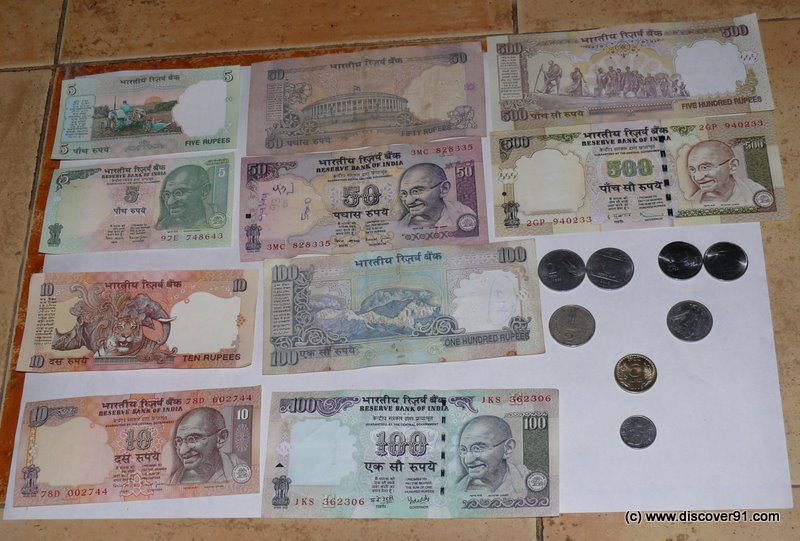The Indian Rupee (International Currency Code: INR) is the official currency in India. Reserve Bank of India (RBI) controls the issue of the currency. Rs. is the common symbol for INR. One Rupee is equal to 100 paise. The singular for paise is paisa. Sometimes it is referred to as the Naya (new) Paisa.
Rupee is derived from the root Sanskrit word Rupyakam - meaning a silver coin. Most Indians will understand 'Rupee', though local languages might have different words for the currency.
| Language | Name for Rupee |
|---|---|
| Assamese | Toka |
| Bengali | Taka |
| Gujarati | Rupiyo |
| Hindi | Rupaya |
| Kannada | Rupayi |
| Malayalam | Roopa |
| Marathi | Rupaye |
| Oriya | Tongka |
| Tamil | Roobai, Roopai, Rubai |
| Telugu | Rupayi |
HERE IS A QUICK CURRENCY / EXCHANGE RATE CONVERTER
Common Indian Currency Notes and Coins - Indian Rupee Notes and Coins

Coins
Indian Rupee coins in circulation now are 25 paise, 50 paise, 1 Rupee, 2 Rupees, 5 Rupees and 10 Rupees. The old 1 paisa, 2 paise, 5 paise and 10 paise coins are not in circulation anymore. Most people do not use the 25 paise coin any more.
Notes
Common currency notes are 5 Rupees, 10 Rupees, 20 Rupees, 50 Rupees, 100 Rupees, 500 Rupees and 1000 Rupees. It is difficult to find 1 and 2 rupee notes now.
All major Indian cities have easily accessible Automatic Teller Machines. All towns and cities have many banks where you can change Travellers checks, US Dollar, Euro and other currencies. Credit cards are widely accepted in all cities, usually for amounts greater than Rs. 250 or so.
Here is the alphabetical list of all the major banks in India, with links to the respective bank website.
|
|
|
|
|
|
|
|
|
|
|
|
|
|
|
|
|
|
|
|
|
|
|
|
|
|
|
|
|
|
|
|
|
|
|
|
|
|
|
|
|
|
|
|
|
|
|
|
|
|
|
|
|
|
|
|
|
|
|
|
|
|
|
|
|
|
|
|
|
|
|
|
|
|
|
|
|
|
|
|
|
|
|
|
|
|
|
|
|
|
|
|
|
|
|
|
|
|
|
|
|
|
|
|
|
|
|
|
|
|
|
|
|
|
|
|
|
|
|
|
|
|
|
|
|
|
|
|
|
|
|
|
|
|
|
|
|
|
|
|
|
|
|
|
|
|
|
|
|
|
|
|
|
|
|
|
|
|
|
|
|
|
|
|
|
|
|
|
|
|
|
|
|
|
|
|
|
|
|
|
|
|
|
|
|
|
|
|
|
|
|
|
|
|
|
|
|
|
|
|
|
|
|
|
|
|
|
|
|
|
|
|
|
|
|
|
|
|
|
|
|
|
|
|
|
|
|
|
|
|
|
|
|
|
|
|
|
|
|
|
|
|
|
|
|
|
|
|
|
|
|
|
|
Financial Institutions |
|
|
|
|
|
|
|
|
|
|
|
|
|
|
|
|
|
|
|